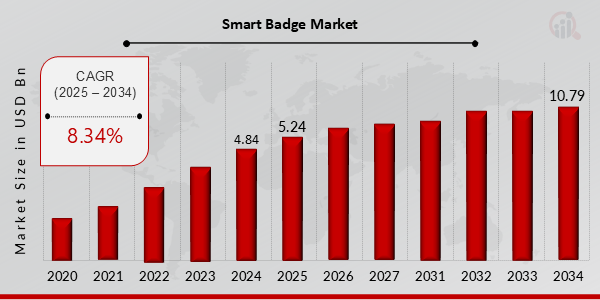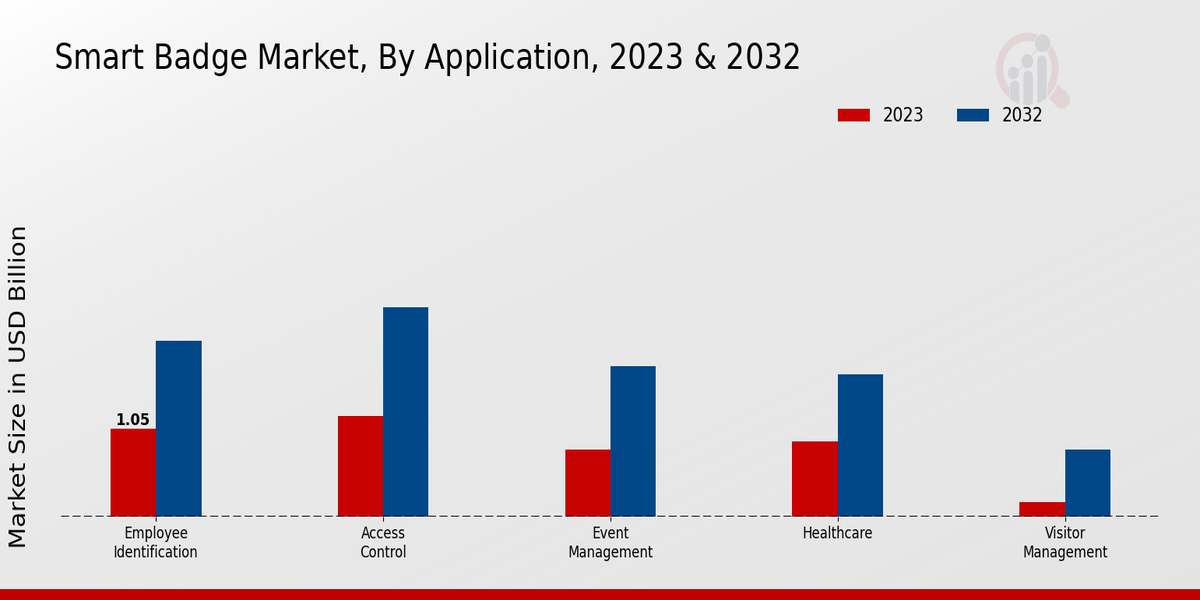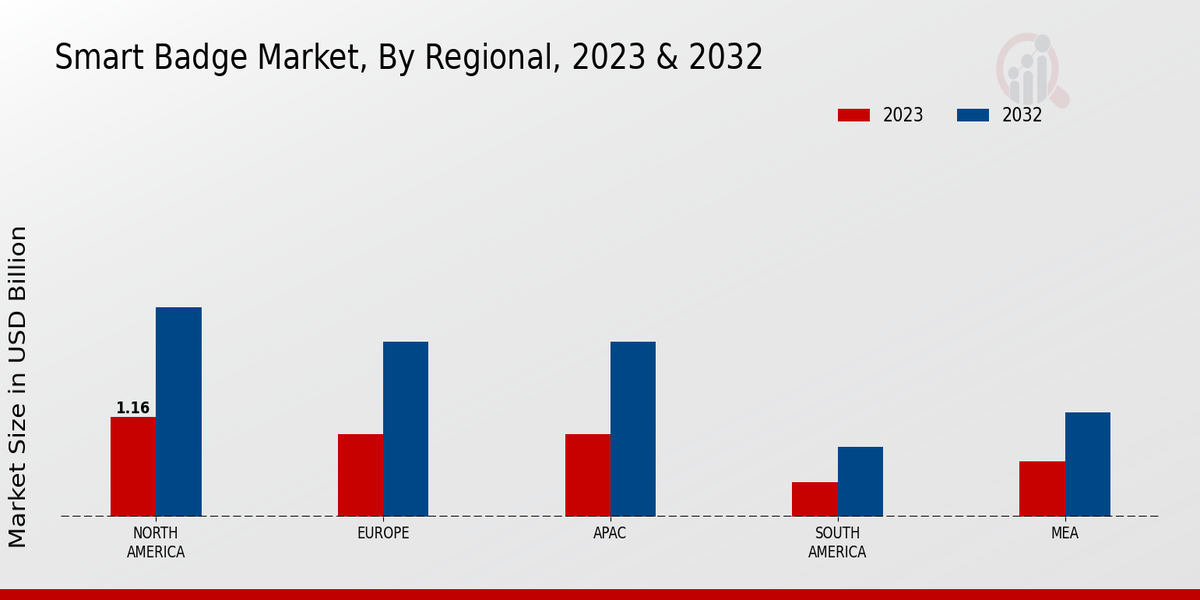Global Smart Badge Market Overview:
Smart Badge Market Size was estimated at 4.84 (USD Billion) in 2024. The Smart Badge Market Industry is expected to grow from 5.24 (USD Billion) in 2025 to 10.79 (USD Billion) till 2034, exhibiting a compound annual growth rate (CAGR) of 8.34% during the forecast period (2025 - 2034).
Key Smart Badge Market Trends Highlighted
The Global Smart Badge Market is witnessing significant growth driven by the increasing demand for efficient identification and access control solutions across various sectors. The expansion of smart technologies in education, corporate environments, and events is making smart badges a favored choice for enhancing security and streamlining operations. As organizations aim to improve their operations and enhance user experience, the adoption of these devices continues to rise. Enhanced functionality, including contactless payments, real-time data sharing, and integration with mobile applications, is also contributing to market growth. There are ample opportunities to be explored within this market, particularly in the development of advanced features such as biometric authentication and IoT connectivity.Companies can capitalize on the growing trend of remote work and hybrid environments, proposing smart badge solutions that cater to the evolving needs of organizations. Additionally, the integration of smart badges with mobile technology provides an avenue for expanding functionalities, thereby increasing their adoption across various industries. Recent trends in the smart badge market include a push for sustainability, leading to the development of eco-friendly materials for badge production. Companies are also focusing on enhancing user experience by integrating features that promote personalization and customizability, allowing users to tailor their smart badges to reflect their identity and preferences.Moreover, partnerships between technology firms and event management companies are becoming more common, further boosting the visibility and utilization of smart badge solutions. These trends indicate a dynamic shift in how organizations perceive and leverage smart badge technology in their operational frameworks.

Source: Primary Research, Secondary Research, MRFR Database and Analyst Review
Smart Badge Market Drivers
Increasing Adoption of Smart Technologies in Various Industries
The Global Smart Badge Market Industry is experiencing significant growth due to the increasing adoption of smart technologies across various sectors. Organizations are recognizing the need for efficient identification and tracking systems that enhance security and operational efficiency. Smart badges incorporate advanced technologies such as RFID, NFC, and biometric features, allowing companies to streamline processes and improve access control. These badges not only serve as identification tools but also enable real-time data tracking, audit trails, and integration with other smart systems.As businesses strive to enhance their security frameworks and improve employee productivity, the demand for smart badges is on the rise. The shift towards digital transformation is pushing organizations to incorporate smart badges as essential elements in their security infrastructure, driving growth in the Global Smart Badge Market Industry. With increasing concerns over unauthorized access and data breaches, companies are investing in sophisticated identification solutions, contributing to the industry's expansion.This trend is reinforced by the push for contactless technologies in response to health and safety considerations, further boosting the demand for smart badges in diverse environments like corporate offices, educational institutions, and healthcare facilities. Additionally, the proliferation of remote work and the need for secure, digital identification solutions are fueling innovations in smart badge technologies, making them indispensable for modern organizations.
Growing Emphasis on Security and Access Control Solutions
The Global Smart Badge Market Industry is significantly propelled by the growing emphasis on security and access control solutions in both public and private sectors. With increasing incidents of security breaches and unauthorized access, organizations are prioritizing the enhancement of their security measures. Smart badges provide an efficient way to manage access control through features such as encryption and secure data transmission. This technological advancement not only secures physical premises but also protects sensitive information, making it crucial for facilities management professionals to adopt smart badge systems.Enhanced security measures are vital for sectors such as healthcare, education, and corporate environments, further driving market growth.
Integration with IoT and Cloud Technologies
The integration of smart badges with the Internet of Things (IoT) and cloud technologies is another driving force behind the growth of the Global Smart Badge Market Industry. By connecting smart badges to IoT devices and cloud systems, organizations can enhance their operational capabilities, streamline user authentication processes, and maintain comprehensive records. This integration offers real-time data analysis and reporting, which enhances decision-making processes and operational efficiency.As more companies recognize the advantages of connected devices and cloud storage solutions, the adoption of smart badges in various applications continues to rise, indicating positive prospects for the market.
Smart Badge Market Segment Insights:
Smart Badge Market Application Insights
The Application segment of the Global Smart Badge Market represents a significant portion of the overall market dynamics, showcasing diverse applications that drive the industry's growth. In 2023, the market was valued at 4.13 USD Billion, indicating robust demand across various sectors. Employee Identification leads this segment with a valuation of 1.05 USD Billion, highlighting its role in enhancing workplace security and operational efficiency. The Access Control application follows closely, valued at 1.2 USD Billion, underscoring the rising need for secure entry solutions in corporate and public venues.Event Management holds a noteworthy share at 0.8 USD Billion, reflecting its essential role in managing large gatherings and ensuring smooth operations. Healthcare, valued at 0.9 USD Billion, demonstrates the critical application of smart badges for patient identification and safety protocols, especially in environments where precise identification is crucial. Visitor Management, though comparatively smaller at 0.18 USD Billion, is gaining traction as organizations seek effective solutions to manage guests and enhance security measures. The cumulative revenue generated from these applications contributes significantly to the overall market growth trajectory and denotes the versatility of smart badge technology across various sectors.With emerging trends emphasizing enhanced security, operational efficiency, and digital engagement, the Global Smart Badge Market is poised for substantial growth, driven by these applications that address both current needs and future demands in the industry.

Source: Primary Research, Secondary Research, MRFR Database and Analyst Review
Smart Badge Market Technology Insights
The Global Smart Badge Market revenue in 2023 reached 4.13 USD Billion, showcasing significant interest in various technologies. This market is structured around several key technologies, including NFC, RFID, Bluetooth, QR Code, and Wi-Fi. The NFC segment holds a significant position due to its convenience and speed in transactions, making it particularly popular for access control and event management applications. RFID is notable for its ability to provide automatic identification and tracking, contributing significantly to efficiency in inventory management and attendance tracking.Bluetooth technology is also gaining traction, especially for short-range communication, making it essential for smart badges that require immediate connectivity with devices. Meanwhile, QR codes remain relevant for their simplicity and versatility, allowing seamless information sharing and verification processes. Wi-Fi technology offers enhanced connectivity options, positioning it as a critical enabler for real-time data access and communications in smart badge applications. Overall, the Global Smart Badge Market statistics reflect a burgeoning industry driven by the increasing demand for secure and efficient identification systems across various sectors.The market growth is further propelled by the adoption of these diverse technologies, each bringing unique advantages that cater to evolving consumer needs.
Smart Badge Market End Use Insights
The Global Smart Badge Market, valued at 4.13 billion USD in 2023, showcases a diverse array of end-use applications that drive its growth and relevance across various sectors. The Corporate sector plays a pivotal role, leveraging smart badges for enhanced security and employee identification, thereby improving operational efficiency. In Healthcare, smart badges facilitate patient tracking and provide immediate access to vital medical information, particularly significant in emergency scenarios. Education institutions utilize smart badges to streamline student attendance and improve campus security, creating a safer environment.Events also recognize the importance of smart badges, employing them for attendee management and networking opportunities. Furthermore, Government applications of smart badges enhance identification and access control for personnel, addressing security challenges. Collectively, these end-use applications contribute to the increased demand and evolving landscape of the Global Smart Badge Market, reflecting its potential to adapt to technological advancements and changing industry needs. The market statistics highlight a significant influence from these diverse sectors, which not only support market growth but also offer varied opportunities for innovation and development within the industry.
Smart Badge Market Material Insights
The Global Smart Badge Market, valued at 4.13 USD Billion in 2023, showcases a diverse Material segment that plays a crucial role in its growth and utility. This segment includes various materials such as Plastic, Metal, Paper, PVC, and Silicone, each contributing uniquely to the functionality of smart badges. Plastic holds a prominent position due to its versatility, cost-effectiveness, and reflectivity, making it an optimal choice for many applications. Metal, while less common, offers durability and a premium look, appealing to industries that require a robust solution.Paper is gaining traction, especially for temporary badges, due to its eco-friendliness and lightweight characteristics. PVC is widely used for its flexibility and resistance to wear, reinforcing its significance in long-term applications. Finally, Silicone brings in a unique advantage with its ergonomic properties, catering to users seeking comfort in wearable technology. These materials exhibit varying demands based on industry needs, reflecting trends such as sustainability and customization that drive market growth. The Global Smart Badge Market revenue in this segment continues evolving alongside increasing technological advancements and the adoption of smart solutions in various sectors.
Smart Badge Market Regional Insights
The Global Smart Badge Market revenue in 2023 is valued at approximately 4.13 USD Billion, reflecting a robust landscape across various regions. North America holds a majority share, valued at 1.163 USD Billion, and is projected to reach 2.429 USD Billion by 2032, driven by technological advancements and increasing adoption in corporate sectors. Europe follows closely with a valuation of 0.962 USD Billion in 2023, expected to grow to 2.024 USD Billion, indicating strong market growth spurred by rising demand for employee identification solutions.The APAC region also maintains a significant portion of the market, similarly valued at 0.962 USD Billion in 2023 and anticipated to mirror Europe’s growth trajectory. Both South America and MEA represent smaller but growing markets, valued at 0.401 USD Billion and 0.642 USD Billion, respectively, in 2023, and expected to see increases to 0.81 USD Billion and 1.214 USD Billion by 2032, reflecting emerging opportunities in these regions. Overall, the Global Smart Badge Market segmentation showcases diverse growth potentials influenced by regional technological adoption trends, innovation, and changing consumer preferences.

Source: Primary Research, Secondary Research, MRFR Database and Analyst Review
Smart Badge Market Key Players and Competitive Insights:
The Global Smart Badge Market is experiencing remarkable growth as organizations increasingly embrace digital solutions for identity management and access control. With the evolution of technology, smart badges, which integrate various features like RFID, NFC, and biometric capabilities, have transformed traditional identification systems into multi-functional tools that enhance security and streamline operations. This market is characterized by several key players who are continually innovating their product offerings to meet the demands of diverse industries such as healthcare, corporate environments, education, and events. Competitive insights reveal that the landscape is not only shaped by technological advancements but also driven by regulatory requirements and user preferences that influence market dynamics. As companies strive to differentiate themselves, forming strategic partnerships and enhancing customer experience have become critical components of their competitive strategy.HID Global stands out in the Global Smart Badge Market with its extensive experience and robust technological offerings. The company has established a strong market presence through its diverse portfolio, which includes smart badges that support a variety of applications in security and access control. HID Global's strengths lie in its commitment to innovation, customer-centric solutions, and extensive distribution channels, allowing it to maintain a leading position in the market. The company excels in providing solutions that integrate seamlessly with existing security systems, thereby ensuring a higher level of convenience and security for organizations. Furthermore, HID Global's investment in research and development underscores its dedication to advancing smart badge technology, positioning itself as a critical player capable of adapting to evolving market trends and customer needs.Impinj is another key player in the Global Smart Badge Market, recognized for its pioneering work in RFID technology. Impinj's smart badge solutions leverage their proprietary technology to enhance asset tracking, identification, and user engagement across various industries. The company’s strengths are grounded in its ability to provide real-time visibility and connectivity, which is essential for organizations looking to enhance operational efficiency and security. Impinj’s innovative approach facilitates seamless interoperability with various systems, making their smart badges adaptable to different environments. Moreover, Impinj’s focus on customer collaboration enables them to tailor solutions that address specific use cases, establishing a strong rapport with clients and ensuring high levels of satisfaction. Through its advanced technology and commitment to support, Impinj continues to solidify its position within the competitive landscape of the Global Smart Badge Market.
Key Companies in the Smart Badge Market Include:
-
HID Global
-
Impinj
-
Zebra Technologies
-
STMicroelectronics
-
Identiv
-
Honeywell
-
Apple
-
Microsoft
-
Proxess
-
Sony
-
Fujitsu
-
Avery Dennison
-
NXP Semiconductors
-
Samsung Electronics
-
LG Electronics
Smart Badge Market Industry Developments
Recent developments in the Global Smart Badge Market indicate a significant uptick in innovation and partnership activities among key players, including HID Global, Impinj, Zebra Technologies, STMicroelectronics, and Identiv. Growth is being driven by advancements in technology integration within smart badges, including the incorporation of RFID and NFC capabilities. Companies such as Honeywell and Samsung Electronics are focusing on enhancing security features, driven by rising concerns over data privacy. Notably, Apple and Microsoft have intensified efforts to integrate smart badge functionalities into their existing ecosystems, thus expanding their market reach. Moreover, mergers and acquisitions in this sector continue to shape the landscape; companies are strategically aligning themselves to bolster their R&D capabilities, although there have not been recent major merger announcements among the specified players. The rise of remote work and rapid digital transformation is further propelling the demand for smart badge systems as organizations look for efficient identity management solutions. This growth in market valuation among companies is fostering competition and innovation, ultimately accelerating the adoption of smart badges across various industries.
Smart Badge Market Segmentation Insights
Smart Badge Market Application Outlook
- Employee Identification
- Access Control
- Event Management
- Healthcare
- Visitor Management
Smart Badge Market Technology Outlook
- NFC
- RFID
- Bluetooth
- QR Code
- Wi-Fi
Smart Badge Market End Use Outlook
- Corporate
- Healthcare
- Education
- Events
- Government
Smart Badge Market Material Outlook
- Plastic
- Metal
- Paper
- PVC
- Silicone
Smart Badge Market Regional Outlook
- North America
- Europe
- South America
- Asia Pacific
- Middle East and Africa
|
Report Attribute/Metric
|
Details
|
|
Market Size 2024
|
USD 4.84 Billion
|
|
Market Size 2025
|
USD 5.24 Billion
|
|
Market Size 2034
|
USD 10.79 Billion
|
|
Compound Annual Growth Rate (CAGR)
|
8.34% (2025-2034)
|
|
Base Year
|
2024
|
|
Market Forecast Period
|
2025-2034
|
|
Historical Data
|
2020-2023
|
| Market Forecast Units |
USD Billion |
| Key Companies Profiled |
HID Global, Impinj, Zebra Technologies, STMicroelectronics, Identiv, Honeywell, Apple, Microsoft, Proxess, Sony, Fujitsu, Avery Dennison, NXP Semiconductors, Samsung Electronics, LG Electronics |
| Segments Covered |
Application, Technology, End Use, Material, Regional |
| Key Market Opportunities |
Growing demand in the corporate sector, Integration with IoT devices, Enhanced security features development, Increasing focus on contactless solutions, Expansion in event management applications |
| Key Market Dynamics |
Technological advancements, Increasing security concerns, Rising adoption in events, Integration with IoT devices, Demand for contactless solutions |
| Countries Covered |
North America, Europe, APAC, South America, MEA |
Frequently Asked Questions (FAQ) :
The Global Smart Badge Market is expected to reach a valuation of 10.79 USD Billion by 2034.
The expected CAGR for the Global Smart Badge Market from 2025 to 2034 is 8.34%.
North America is projected to have the largest share, valued at 2.429 USD Billion in 2032.
The Employee Identification segment is projected to grow to 2.1 USD Billion by 2032.
The Healthcare application segment is expected to be valued at 1.7 USD Billion in 2032.
Key players include HID Global, Zebra Technologies, Apple, and STMicroelectronics, among others.
The Access Control application is projected to be valued at 2.5 USD Billion in 2032.
The Visitor Management application is expected to be valued at 0.8 USD Billion in 2032.
The Global Smart Badge Market is valued at 4.13 USD Billion in the year 2023.
The APAC region is projected to have a market value of 2.024 USD Billion by 2032.

















